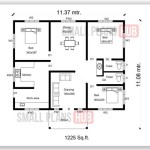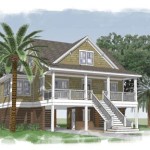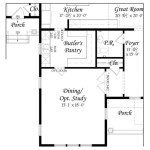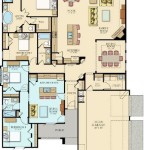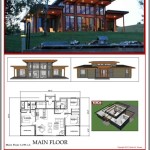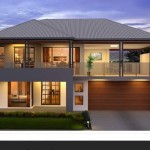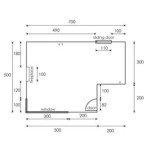Floor Plans For Barndominiums: Optimizing Space and Design
Barndominiums, a fusion of barn and condominium, have gained considerable traction as a cost-effective and aesthetically versatile housing solution. The allure lies in their open floor plans, durable construction, and potential for customization. However, the success of a barndominium project hinges significantly on a well-designed floor plan. The floor plan not only dictates the flow of movement and functionality within the dwelling but also plays a crucial role in maximizing the use of space, reflecting the owner’s lifestyle, and potentially increasing the property’s value.
The process of designing a barndominium floor plan involves careful consideration of various factors, including the intended use of the space, the number of occupants, and the desired architectural style. Unlike conventional homes, barndominiums typically feature large, open areas, which require strategic planning to avoid a cavernous or impersonal feel. Thoughtful zoning, smart use of furniture, and strategic placement of walls are essential to creating distinct living spaces within the larger structure. This article will explore key considerations and practical strategies for developing effective barndominium floor plans.
Understanding Barndominium Structure and Design Principles
Before embarking on the design of a barndominium floor plan, it is crucial to understand the structural characteristics that distinguish this type of dwelling. Barndominiums are typically built using pole barn construction or metal framing, which allows for large, unobstructed interior spaces. This structural freedom presents both opportunities and challenges. The expansive open areas can be configured in numerous ways, but they also require careful planning to ensure functionality and comfort. The design must seamlessly integrate the living spaces, such as bedrooms, bathrooms, and kitchen, with the inherent open concept of the barndominium.
The metal exterior offers exceptional durability and resistance to the elements, but it also requires attention to insulation to ensure energy efficiency and comfort. Proper insulation is critical for controlling temperature fluctuations and minimizing noise transfer, especially in areas with extreme climates. The integration of windows and doors should be carefully considered to maximize natural light and ventilation while maintaining energy efficiency and security. The location and size of these openings will greatly impact the overall feel and functionality of the barndominium. Furthermore, the floor plan must account for the placement of utilities, such as plumbing, electrical wiring, and HVAC systems, ensuring they are accessible for maintenance and repair without compromising the aesthetic appeal of the interior.
The principles of universal design are also relevant when planning the interior space. Considerations such as wide doorways, accessible bathrooms, and single-level living can make the barndominium more comfortable and adaptable for occupants of all ages and abilities. This proactive approach not only enhances the present-day usability but also increases the long-term value and marketability of the property. Incorporating these principles into the floor plan early in the design process can save significant time and expense compared to retrofitting the structure later.
Key Elements of an Effective Barndominium Floor Plan
Several key components contribute to an effective barndominium floor plan. These elements must be carefully considered and integrated to create a harmonious and functional living space. Zoning, flow, and natural light are all vital considerations.
Zoning: Dividing the open space into distinct zones for different activities is paramount. The floor plan should delineate areas for living, sleeping, cooking, and working, ensuring each zone has its appropriate level of privacy and functionality. Consideration should be given to the placement of the master suite, guest bedrooms, and common areas. The kitchen area, often serving as the heart of the home, needs to be thoughtfully designed with ample counter space, storage, and appropriate appliances. Islands and peninsulas can effectively create visual separation and provide additional workspace. Dedicated areas for laundry, mudrooms, and home offices should also be strategically located to maximize convenience and minimize clutter.
Flow: The flow of movement throughout the barndominium should be intuitive and unobstructed. The layout should facilitate easy navigation between different zones, minimizing unnecessary steps and awkward transitions. Clear pathways and open sightlines contribute to a sense of spaciousness and connectivity. The placement of furniture and fixtures should be carefully considered to avoid obstructing pathways and creating bottlenecks. Hallways should be wide enough to accommodate traffic flow, especially in areas with high foot traffic. A well-designed flow pattern enhances the overall usability and enjoyment of the barndominium.
Natural Light: Maximizing natural light is crucial for creating a bright and inviting interior environment. Large windows, skylights, and strategically placed doors can flood the interior with natural light, reducing the need for artificial lighting during the day. The orientation of the barndominium on the property should be carefully considered to optimize sunlight exposure. South-facing windows can capture sunlight during the winter months, while strategically placed overhangs can provide shade during the summer months. The use of light-colored interior finishes can further enhance the effect of natural light, creating a more open and airy atmosphere. The placement of windows should also consider views and privacy, ensuring that the occupants can enjoy the surrounding landscape without compromising their sense of personal space.
Practical Strategies for Optimizing Space Utilization
Given the open nature of barndominium structures, maximizing space utilization is an essential aspect of floor plan design. Smart storage solutions, multi-functional spaces, and strategic furniture placement are crucial elements.
Smart Storage Solutions: Adequate storage is essential for maintaining a clutter-free and organized living environment. Built-in storage solutions, such as shelving units, cabinets, and drawers, can maximize the use of vertical space and minimize the footprint of storage furniture. Incorporating storage into unconventional spaces, such as under the stairs or in attic nooks, can further expand storage capacity. The kitchen area should be equipped with ample cabinet space, pantry storage, and organizers to accommodate cookware, utensils, and food supplies. Bedrooms should feature spacious closets with customizable shelving and hanging rods. A well-designed storage system not only maximizes space but also enhances the overall organization and functionality of the barndominium.
Multi-Functional Spaces: Designating spaces that can serve multiple purposes is an effective way to maximize space utilization in a barndominium. A guest bedroom can double as a home office, a living room can be transformed into a home theater, and a dining area can function as a workspace. Incorporating furniture that can be easily converted from one use to another, such as sofa beds, folding tables, and modular seating, enhances the flexibility of the space. Multi-functional spaces should be designed with consideration for acoustics, lighting, and privacy. Soundproofing walls and installing dimming lights can help create a comfortable and functional environment for various activities. The use of room dividers, curtains, or sliding doors can provide additional privacy when needed.
Strategic Furniture Placement: The placement of furniture can significantly impact the perceived size and functionality of a space. Avoiding overcrowding and leaving ample open space can create a sense of spaciousness. Arranging furniture to define distinct zones within the open floor plan can enhance the organization and flow of the space. Using area rugs to delineate living areas, placing furniture strategically to create conversational groupings, and selecting furniture that is appropriately scaled for the space are all effective strategies. Avoiding large, bulky furniture and opting for lighter, more streamlined pieces can further enhance the sense of openness. Thoughtful furniture placement can transform a barndominium from a cavernous space into a comfortable and inviting home.
In addition to these strategies, careful consideration should be given to the placement of appliances, fixtures, and built-in elements. Positioning appliances to optimize workflow in the kitchen, ensuring adequate clearance around furniture, and strategically placing lighting fixtures to highlight architectural features can all contribute to a more functional and aesthetically pleasing barndominium floor plan. Ultimately, the goal is to create a space that is both visually appealing and highly functional, reflecting the unique needs and preferences of the occupants.

The New Guide To Barndominium Floor Plans Houseplans Blog Com

Easy Barndominium Floor Plans Cad Pro

Barndominium Floor Plans The Barndo Co

99 Barndominium Floor Plans With Pictures 2024 Updated Design Home Building House

Barndominium Floor Plans

Barndominium House Layout

Single Story Barndominium Floor Plans 8 Great Ideas

Cedar Springs Barndominium House Plan Design 4 Bed 3 Bath Double Garage Drawings Blueprints Foundation Electrical Lighting

Create Your Dream Home Now Planner5d

5 Floor Plans For Your Barndominium Home Nation
Related Posts

